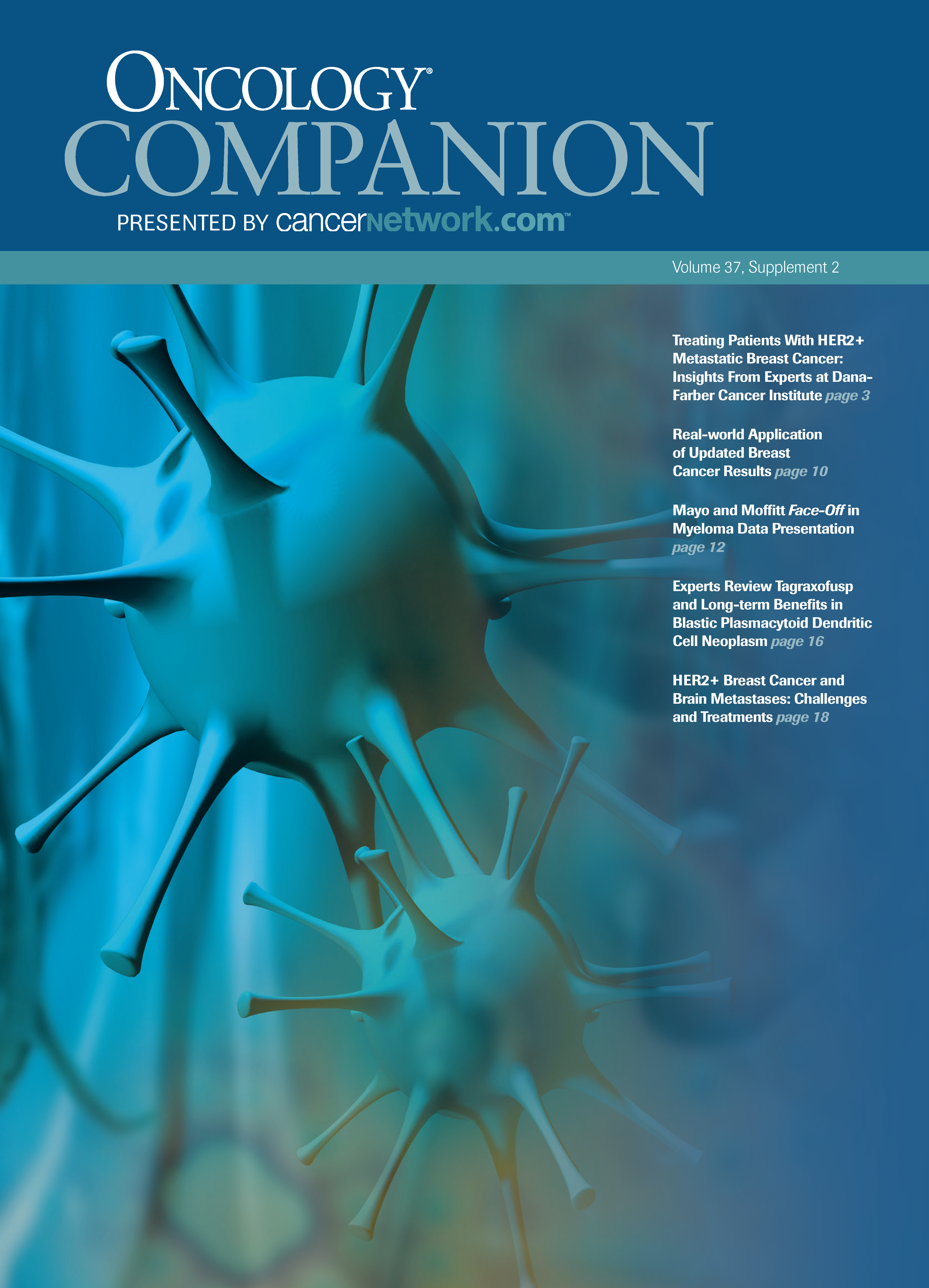Recap: Experts Review Tagraxofusp and Long-term Benefits in Blastic Plasmacytoid Dendritic Cell Neoplasm
Expert hematologist-oncologists review the clinical data on the long-term use of tagraxofusp and share their real-world experiences.

Trying to identify patients with blastic plasmacytoid dendritic cell neoplasm (BPDCN) is very difficult, and clinicians are still figuring out how best to treat the rare and aggressive hematologic malignancy. However, in 2018, the FDA approved the CD123- directed cytotoxin tagraxofusp-erzs (Elzonris) to treat BPDCN in adults and children aged 2 years or older.1 The European Medicines Agency followed 2 years later, approving the drug for adult patients.2 Last summer, investigators published new longer-term data showing tagraxofusp led to durable responses and enabled many patients to bridge to stem-cell transplants, which is considered the ultimate therapeutic goal to achieve long-term survival.3
Two experts in BPDCN, Thomas Leblanc, MD, associate professor of medicine and associate professor in population health sciences at the Duke Cancer Institute, in Durham, North Carolina; and Bhumika Patel, MD, a hematologic oncologist at Prisma Health, in Greenville, South Carolina, discussed how tagraxofusp is changing the treatment landscape for BPDCN in a recent edition of Between the Lines, hosted by CancerNetwork®. The physicians focused on results that were reported in a recent Journal of Clinical Oncology study, discussed current treatment recommendations, and highlighted the importance of collaboration between academic and community oncologists.
Key Long-term Findings
Led by corresponding author Naveen Pemmaraju, MD, of The University of Texas MD Anderson Cancer Center, the tagraxofusp study (NCT02113982) looked at the therapy’s efficacy as monotherapy in 65 treatment-naïve patients with BPDCN and 19 patients with relapsed/refractory (R/R) disease. The study was divided into 4 stages, concluding with a final continued access stage. Patients received the therapy via daily intravenous infusion on the first 5 days of each 21-day cycle. All but 2 patients had an ECOG performance status of 0 or 1. The median age of the treatment-naïve cohort was 68, and the median age of the R/R group was 72.
After a median follow-up of 34 months, the data showed a 75% overall response rate (ORR). The median overall survival was 15.8 months (95% CI, 9.7-25.8). Fifty-seven percent of patients had a complete response (CR) or clinical CR, which was defined as having residual skin abnormalities but no indications of active disease. Nineteen patients with CRs or clinical CRs were bridged to stem cell transplant. The median time to remission was 39 days, and the median CR duration was 24.9 months (95% CI, 3.8-not reached).
Prognosis and Treatment in R/R Cases
One reason BPDCN can be hard to diagnose, and treat is because it is uncommon. It is also aggressive—patients with the diagnosis typically survive about 2 years, according to a multicenter analysis published in 2019.4
In the trial, most patients with BPDCN have skin involvement (79%), as well as bone marrow involvement (63%).
Historically, LeBlanc said, physicians used a range of therapies—and classes of therapies—to treat the disease, including chemotherapy regimens designed to treat acute myeloid leukemia (AML), or acute lymphocytic leukemia (ALL). However, he said the new data make tagraxofusp the clear choice for most patients with BPDCN.
“This is by far my first, second, third recommended kind of treatment for any particular patient,” he said.
In a relapsed/refractory setting, Patel said patient fitness often becomes a major consideration, particularly because most patients with R/R disease are in their 60s or 70s. Patel said she consults academic medical centers to ensure patients benefit from the latest therapies.
“I always look at clinical trials as a first option because there’s a lot of great studies coming down the pipeline that are being evaluated,” she said.
Among those are trials looking at the use of venetoclax (Venclexta) or chimeric antigen receptor (CAR) T-cell therapies that target CD123, which is expressed in BPDCN cells.
Administering Tagraxofusp
Though tagraxofusp is considered the preferred first-line therapy for BPDCN, it is not a good fit for all patients. Individuals who could not tolerate capillary leak syndrome, those with significant liver disease or cardiac issues, or those unwilling to be hospitalized for treatment might not be appropriate candidates for tagraxofusp, LeBlanc said.
“Like anything in cancer care, it becomes a shared decision-making kind of scenario,” he said. National Comprehensive Cancer Network (NCCN) guidelines call for the first cycle to be administered in a hospital setting so that patients can be closely monitored for adverse effects (AEs).5 Subsequent cycles can be administered in an outpatient setting, depending on how well the patient tolerates the therapy.
Due to the risk of capillary leak syndrome, LeBlanc said it is important to analyze patients’ albumin levels prior to initiating therapy. In some cases, patients require albumin supplementation to boost their ability to tolerate treatment.
LeBlanc commented that there are a number of signs that indicate capillary leak syndrome is occurring. “When patients have capillary leak syndrome, what we commonly will see is a precipitous drop in their albumin level,” he said. Significant third spacing of fluids, rapid weight gain, and peripheral edema are also signs of capillary leaks. Sometimes changes in creatinine levels and creatinine clearance occur, which he said is likely due to hypoperfusion caused by capillary leakage.
In the trial, 21% of patients experienced capillary leak syndrome, but only 7% of patients discontinued treatment due to AEs, suggesting that AEs were tolerable for most people.
Another concern for physicians treating patients with tagraxofusp is the risk of myelosuppression. Patel noted that the majority of AEs in the tagraxofusp study were thrombocytopenia and anemia, which occurred in 43% and 24% of patients, respectively. She said these AEs are generally very manageable.
“You can manage those supportive transfusions,” Patel said. “Even after the discharge of a patient once they’re cleared clinically, you can manage these cytopenias as outpatient [care].”
Patel added that it was notable that neutropenias and infections were not on the list of AEs observed in the trials.
Leveraging Academic/ Community Cooperation
Both Patel and LeBlanc said collaboration between academic cancer centers and community oncologists is crucial to ensure accurate diagnosis of patients with BPDCN. According to Patel, in most cases, skin manifestations are the first clue that a patient might have BPDCN, although some patients may have myeloma lymph node extramedullary disease.
“Getting a good biopsy, working with your hematopathologist, and dermatology would be imperative to get a diagnosis of BPDCN,” she said.
LeBlanc added that he sometimes has patients with only skin manifestations who went undiagnosed for a substantial amount of time due to the resemblance between skin manifestations of the malignancy and normal bruising. “So you have to think about it and suspect it,” LeBlanc said. “Then, CD123 becomes important because that’s a critical piece of what has to be present to clinch this diagnosis.”
Key Takeaways
LeBlanc’s main takeaway from the study is that tagraxofusp has an impressive ORR and appears to be a highly effective bridging therapy for many patients. However, he said the data also make clear that vigilance is required when treating patients with the therapy.
“The challenge is you have to know about the nuances of capillary leak, what that looks like, how to address it, and to follow what’s in those NCCN guidelines about good supportive care if you’re going to safely give this therapy,” he said.
Patel said she urges community oncologists to make sure they get a solid, comprehensive patient history and physical, and use skin and bone marrow biopsies to aid diagnosis.
If the patient ends up with a BPDCN diagnosis and is a good candidate for tagraxofusp, she said she would be in regular contact with colleagues like LeBlanc at academic medical centers.
“If the patient is fit, we use tagraxofusp up front and start working on their transplant eligibility up front,” she said.
References
- FDA approves tagraxofusp-erzs for blastic plasmacytoid dendritic cell neoplasm. News release. FDA. December 21, 2018. Accessed January 15, 2023. https://bit.ly/3WkFjih
- Approval of the marketing authorisation of Elzonris (tagraxofusp). News release. European Medicines Agency. November 13, 2020. Accessed January 15, 2023. https://bit.ly/3GJ0wgo
- Pemmaraju N, Sweet KL, Stein AS, et al. Long-term benefits of tagraxofusp for patients with blastic plasmacytoid dendritic cell neoplasm. J Clin Oncol. 2022;40(26):3032-3036. doi:10.1200/JCO.22.00034
- Taylor J, Haddadin M, Upadhyay VA, et al. Multicenter analysis of outcomes in blastic plasmacytoid dendritic cell neoplasm offers a pretargeted therapy benchmark. Blood. 2019;134(8):678-687. doi:10.1182/blood.2019001144
- NCCN. Clinical Practice Guidelines in Oncology. Acute myeloid leukemia, version 3.2022. Accessed January 16, 2023. https://bit.ly/2kiTUz4
EP: 1.An Overview on Blastic Plasmacytoid Dendritic Cell Neoplasm and Tagraxofusp Therapy
EP: 2.Long-Term Efficacy Data of Tagraxofusp in the 1L Management of BPDCN
EP: 3.Tagraxofusp in BPDCN: Optimizing the Management of Adverse Events
EP: 4.BPDCN Management: Tagraxofusp as a Bridge to Stem Cell Transplant
EP: 5.Addressing Myelosuppression While Managing BPDCN With Tagraxofusp
EP: 6.Tagraxofusp in BPDCN: Practical Advice and Future Directions in Care
EP: 7.Recap: Experts Review Tagraxofusp and Long-term Benefits in Blastic Plasmacytoid Dendritic Cell Neoplasm

Navigating AE Management for Cellular Therapy Across Hematologic Cancers
A panel of clinical pharmacists discussed strategies for mitigating toxicities across different multiple myeloma, lymphoma, and leukemia populations.